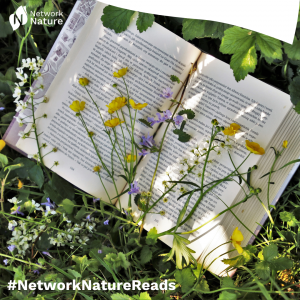
What is NetworkNature Reads?
#NetworkNatureReads is inspired by #ReadingRainbow and the #NewYorkTimes #ByTheBook series, both of which spread a love of reading by highlighting stand out books and the people who love them. Our goal is to do the same, but with a #naturebasedsolutions flavor. Every month, we will feature one book selected by a NetworkNature member. We believe that literature widens perspectives and can foster connection with human and environmental communities. Read Wild Geese by Mary Oliver if you aren’t sure what we mean.
This month’s interviewee is ICLEI's Katherine Peinhardt. Want to get involved? Contact hello@networknature.eu to suggest a book!
Tell us about yourself! What role do nature and reading play in your life?
Nature plays a definite role in my life – living in the Black Forest has made me really appreciate hiking – I have a very active dog, and this is one of the best ways to tire her out! Reading is a pastime with which I really want to better connect as an adult – as a kid, I read voraciously, but now am looking for ways to get myself to focus. My habit of starting many books at once does not help…
Which book did you pick and why?
The Heat Will Kill You First by Jeff Goodell is an alarming read, first and foremost. It digs into the topic of extreme heat in the context of climate change, which is known as a “silent killer.” It is one of the climate hazards getting more attention in recent years: “A recent study by the National Academy of Sciences found that globally, the heat risk in urban areas tripled over the last forty years, putting 1.7 billion people at risk.” Heat is also something that affects communities very unevenly, and relies on strong social ties in order to make sure that people more susceptible to heat stress are taken care of in the case of an extreme heat event. Heat resilience is complex because of its position at the nexus of such a variety of themes like public health, social cohesion, urban nature, building design and materials, and more.
Can you share a specific moment from the book that resonates with you personally? How does it connect to your work with Nature-based Solutions projects?
After this summer’s heat waves, it’s hard not to connect with the book’s anecdotes. The stress that heat puts on the body is something that I have definitely had trouble with this year. That is why I was surprised to learn that our bodies can also adjust to hotter climates: “after you spend a few weeks in a hot climate, your body makes subtle adjustments that help you better tolerate heat stress. Your normal deep body temperature drops. Your body sweats at a lower temperature, and so there is less strain on your heart… [ and ] your heart pumps more blood per stroke.” Though these adjustments do not last long if a person leaves a hot place, it is pretty incredible to see how linked our metabolisms are with the world around us.
Even so, heat is incredibly dangerous, and can sneak up on us in the form of so-called “classic heat stroke,” which affects very young or older people, or those with medical conditions like cardiovascular disease. However, a less-known form is “exertional heat stroke” which can hit people who would not usually be considered high-risk. Goodell even says: “Being young or in great shape won’t save you. In fact, being young and strong allows you to fight off the warning signs of heat exhaustion until it is too late.” Heat affects everyone, and that’s why it is so crucial as a climate hazard, even if it is less tangible than other climate disasters.
Meanwhile, heat is a topic that we work on within the ICLEI Europe Resilience and Climate Adaptation team. Our project Commit2Green works on hazards like extreme heat through the lens of urban greening and renaturing, including in public spaces. The basic idea that planning for hot days through amenities like shade, greenery, and water in the public realm is central to some of the project’s work, though heat is just one of the hazards we focus on there.
If you were recommending this book to a colleague or a friend within the conservation community, what key takeaway or message would you highlight?
Just how quickly our exposure to heat is growing – and that nature can be a part of how we protect our communities.
